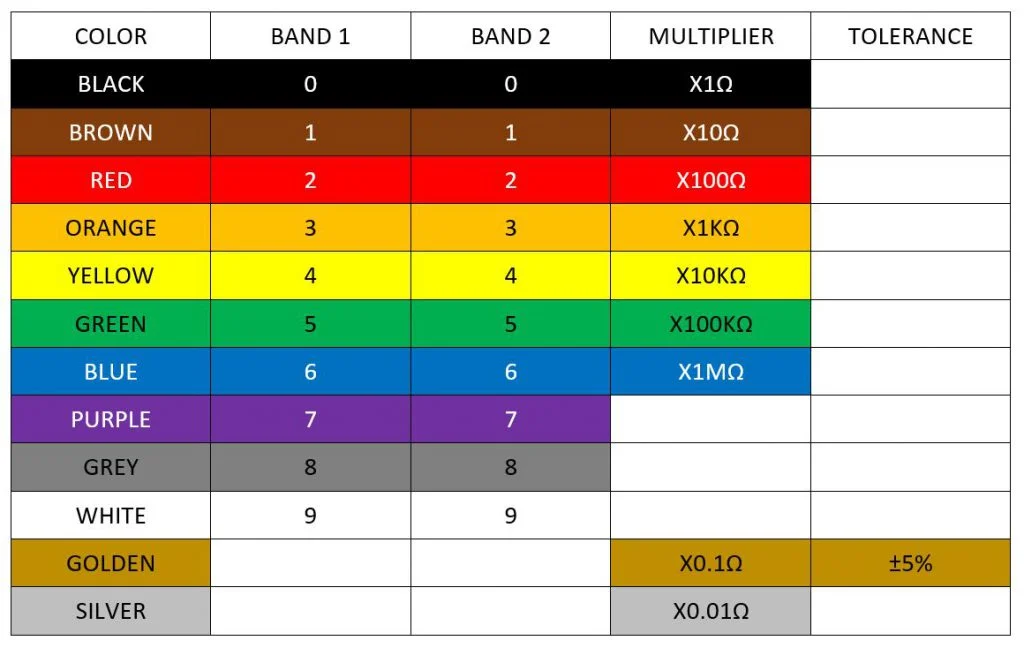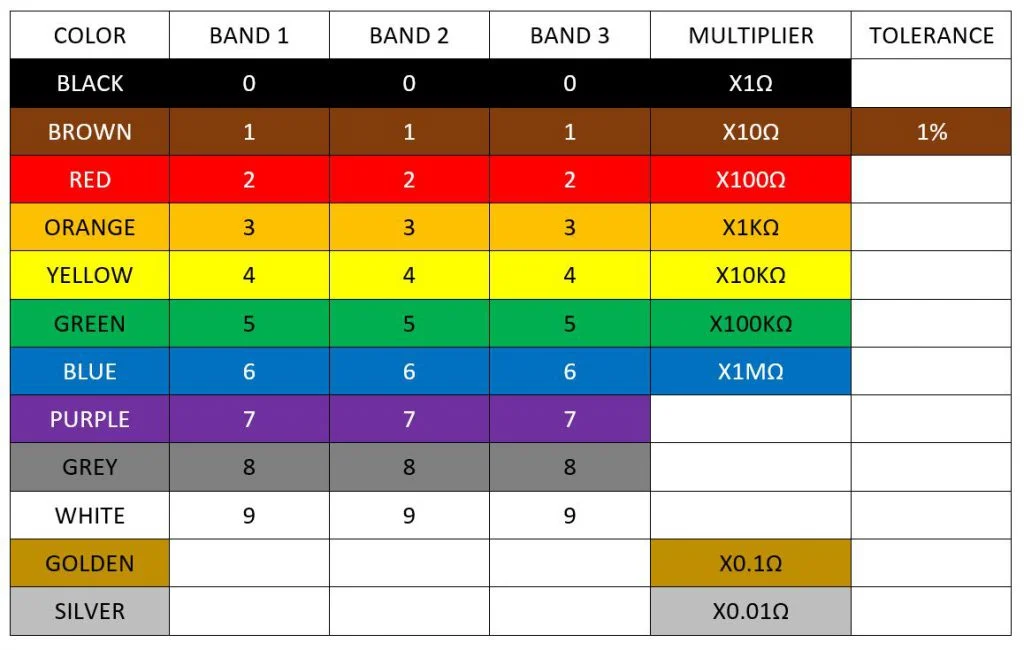Did you get one of our diy effect pedal kits and need help to read resistor values? Then keep reading! This is one of the most important skills to anyone interested into electronics and effect pedal building, and in this post we’ll explain step by step how to read the value of the resistors we send with our effect pedal kits.
RESISTOR VALUE
On the DIY world (“Do It Yourself”), knowing how to read resistor values is essential. Resistor reading speed will keep improving as you practice, to the point you’ll immediately identify them. If you’re just starting building effect pedals and are not very used to the color band code, we recommend you to use a cheat sheet with the color-number equivalence.
Before starting reading resistor values, we’ll explain briefly resistor’s 3 main properties:
- Resistance value
- Maximum power allowed by the resistor
- Resistor’s tolerance
1 – Resistance value
A resistor’s resistance value is its most important property, and it’s written on the body of the resistor with a color band code. In broad terms, when facing the same voltage a resistor with a smaller resistance will allow more current to flow through it, which allows, along with other parts, to design circuits as amplifiers and volume controllers.
In the next section we’ll cover in detail how to read the resistance value of different kind of resistors.
2 – Power
When a current flows through a resistor, it gets hotter and starts dissipating energy. A resistor’s power value sets the maximum amount of energy the resistor can dissipate in the form of heat without getting damaged. This power value depends mostly on the resistor’s size (the bigger the resistor, the higher the power it can dissipate). For small electronics, 1/4W (0,25W) resistors are the most used. These are the ones we use in all of our effect pedal kits. For these resistors, the lenght is between 6 mm and 6,5 mm and the distance between pins between 7,5 mm and 8 mm.
3 – Tolerance
In real world, electronic parts are not perfect and can have light deviations from the “ideal” model. A resistor’s tolerance indicates the maximum variation from the theoretical resistance value a resistor will have. For example, a 100kΩ resistor with a 1% tolerance will have a resistance value between 99kΩ and 101kΩ. These variations are not important as electronic circuits are always designed keeping them in mind.
Tolerance value is marked with a color band in the resistor’s body as we explain in the next section. The resistors in our effect pedal kits are mostly 1% tolerance, only in a few cases you’ll get a 5% one as some of them are not available as 1%.
CARBON FILM – RESISTOR VALUE – 4 Band Color Code
Let’s start with 4 band resistors. The 1st band is the one nearest the border of the body, while the 4th (the tolerance) is a bit farther from the other three. For a good reading, we recommend to place the resistor so the tolerance band is in the right side.
There’s 9 color possibilities for the 1st band, and each one corresponds to a number between 0 (black) and 9 (white), following this order: black, brown, red, orange, yellow, green, blue, purple, grey and white. Carbon film resistors used in our effect pedal kits all have ± 5% tolerance, so the tolerance band will always be golden. You can find the color-number equivalence in the next chart:

Both the 1st and the 2nd bands have the same color code, and they set the 1st and 2nd digit of our resistor’s resistance value. Therefore, we can have a number between 0 and 99. The third band is the multiplier, a factor we’ll have to multiply our two digits by to get the final value.
To make it easier to understand here’s a carbon film resistor color code example:

1st Band: Yellow -> 4
2nd Band: Purple -> 7
3rd Band: Orange -> x1kΩ
4th Band (tolerance): ± 5%
Final resistor value:47 x 1kΩ = 47000Ω = 47kΩ with ± 5% tolerance
The maximum number of combinations of the first 2 bands is too high, and because of that a standard set of numbers has been adopted. These sets have a well defined pattern that repeats through each multiplier decade. There are different sets depending on the number of values needed; for ± 5% tolerance resistors, the E24 set is used. This set has the following 24 values:
10, 11, 12, 13, 15, 16, 18, 20, 22, 24, 27, 30, 33, 36, 39, 43, 47, 51, 56, 62, 68, 75, 82, 91.
This means the first 2 bands, that theoretically could have any value between 0 and 99, will only have one of these 24 valuesthat will then be multiplied by the factor set by the third band. For example, a resistor with an orange 1st and 2nd band, and thus a numeric value of 33, will have a final value of 0,33Ω, 3,3Ω, 33Ω, 330Ω, 3,3KΩ, 33KΩ, 330KΩ, 3,3MΩ or 33MΩ.
METAL FILM – RESISTOR VALUE – 5 Band Color Code
Metal film resistors have a blue body and are also known as precision resistors. Tolerance is lower than for carbon film resistors (lower than 5%), and they have 5 color bands instead of 4.
The color code works like with carbon film resistors, but now the numeric value will be given by the first 3 bands and not by the first 2. The 4th band is the multiplier. Metal film resistors in our kits have a ± 1% tolerance, so the 5th band (tolerance) will be brown. In the next chart you can find the color-number equivalence for metal film resistors.

1st, 2nd and 3rd bands use the same color code and give, respectively, the 1st, 2nd and 3rd digits of our resistor’s value. We can therefore have a number between 0 and 999. The 4th band is the multiplier, a factor we’ll have to multiply our number by to get the final value.
To make it easier here’s a metal film color code reading example:

1st Band: Yellow -> 4
2nd Band: Purple -> 7
3rd Band: Black -> 0
4th Band: Red -> x100Ω
5th Band (tolerance): ±1%
Final resistor value:470 x 100Ω = 47000Ω = 47kΩ with ± 1% tolerance
Having a 3rd digit, the multiplier is now a decade higher regarding carbon film resistors. Thus, a 47k resistor coded with 4 bands will have an orange multiplier color band while coded with 5 bands it will have a red one.
As for carbon film resistors, not every value between 0 and 999 is available. In this case, the E96 set is used, with the following 96 values:
100, 102, 105, 107, 110, 113, 115, 118, 121, 124, 127, 130, 133, 137, 140, 143, 147, 150, 154, 158, 162, 165, 169, 174 178, 182, 187, 191, 196, 200, 205, 210, 215, 221, 226, 232, 237, 243, 249, 255, 261, 267, 274, 280, 287, 294, 301, 309, 316, 324, 332, 340, 348, 357, 365, 374, 383, 392, 402, 412, 422, 432, 442, 453, 464, 475, 487, 499, 511, 523, 536, 549, 562, 576, 590, 604, 619, 634, 649, 665, 681, 698, 715, 732, 750, 768, 787, 806, 825, 845, 866, 887, 909, 931, 953, 976.
Following these steps you won’t have any problem building any of our kits. Nothing is more satisfying than build your own effect pedals, and even if you’re new to electronics we highly encourage you to give it a try!
Here you’ll find all of our effect pedal kits
Besides, all of our effect pedals and kits are customizable, build an effect pedal that is truly yours!

